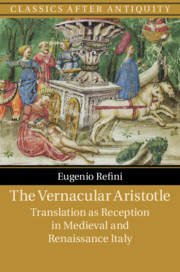Book contents
- The Vernacular Aristotle
- Classics after Antiquity
- The Vernacular Aristotle
- Copyright page
- Dedication
- Contents
- Figures
- Series Editors’ Preface
- Acknowledgements
- Notes on the Text
- Introduction
- Chapter 1 Taming the Philosopher
- Chapter 2 The Master of Those Who Know (and Those Who Don’t)
- Chapter 3 Family BusinessReadying the Ethics for the Layman
- Chapter 4 The Philosopher, the Humanist, the Translator and the Reader
- Chapter 5 Abridging the Philosopher(s)
- Conclusion
- Bibliography
- Index
Chapter 3 - Family BusinessReadying the Ethics for the Layman
Published online by Cambridge University Press: 10 February 2020
- The Vernacular Aristotle
- Classics after Antiquity
- The Vernacular Aristotle
- Copyright page
- Dedication
- Contents
- Figures
- Series Editors’ Preface
- Acknowledgements
- Notes on the Text
- Introduction
- Chapter 1 Taming the Philosopher
- Chapter 2 The Master of Those Who Know (and Those Who Don’t)
- Chapter 3 Family BusinessReadying the Ethics for the Layman
- Chapter 4 The Philosopher, the Humanist, the Translator and the Reader
- Chapter 5 Abridging the Philosopher(s)
- Conclusion
- Bibliography
- Index
Summary
Chapter 3 concentrates on translations commissioned by members of the Giustiniani family in Venice. The chapter first analyses the earliest Italian translation of the Nicomachean Ethics, authored around 1430 by the Augustinian theologian Antonio Colombella at the behest of Pancrazio Giustiniani. Based on the medieval Latin version of the Ethics, Colombella’s translation can be read as an attempt to adapt the academic study of Aristotle to the needs of vernacular readers. Of particular interest are the insights into coeval translation practice and theory offered by the prologue. The chapter looks then at the annotated translation of the pseudo-Aristotelian treatise On Virtues and Vices by the Dominican Lazzaro Gallineta, who dedicated it to Giustiniani’s son-in-law, Bernardo, in the 1460s. The work testifies to the permeability between scholastic traditions and new humanist trends; it also gives us some indication as to how a challenging text like the Ethics could be adapted to a lay readership. The chapter includes a discussion of Benedetto Cotrugli’s Libro de l’arte della mercatura (1458) and the mercantile milieu into which forms of patronage such as the Giustiniani’s belonged.
Keywords
- Type
- Chapter
- Information
- The Vernacular AristotleTranslation as Reception in Medieval and Renaissance Italy, pp. 86 - 127Publisher: Cambridge University PressPrint publication year: 2020

